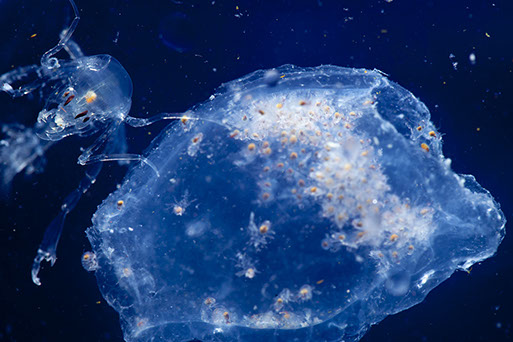Hyperiid Amphipods
Hyperiid amphipods are marine crustaceans that can be found at many depths in the water column, throughout most of the world. Unlike most of the crustaceans that we study in the ocean, hyperiid amphipods typically do not eat phytoplankton or smaller zooplankton. Instead many hyperiid amphipods are specially adapted to act as parasites or micropredators of gelatinous zooplankton including salps, doliolids, and jellies. Hyperiid amphipods commonly range from only about a millimeter to over a a centimeter in size.
Phronima is one common type of hyperiid amphipod that we have caught in many net tows in the California Current Ecosystem and in waters off of New Zealand (shown in the picture on the right). Phronima has a couple of special adaptations that allow it to excel in its ecological niche. It has two legs that have been modified into large grasping appendages to allow it to hold onto its salp prey. It also has very large eyes that allow it to efficiently find its prey in the open ocean. Phronima also has a fascinating approach to safely rearing its young. When it preys upon a salp, it eats the inside, but uses the outside of the salp to build a barrel that the adult Phronima will then live inside and lay its eggs within. The adult will then swim with the barrel as it searches for food. Once the young hatch they will be protected inside the barrel as they start to grow and receive food that is brought in by their mother. The picture to the right shows Phronima with its barrel with young hatched inside. 
Hyperiid amphipods can play important roles as links in the marine ecosystem. Many fish, squid, and seabirds are well-adapted to feeding on crustaceans, but are less likely to feed on salps and other gelatinous organisms. Thus when during salp or jelly blooms food chain transfer efficiency to fisheries can be reduced. However, when hyperiid amphipods are abundant they can feed extensively on the gelatinous organisms and then serve as ideal prey for many higher predators. For instance the hyperiid amphipod Themisto gaudichaudii is a species that preys on salps, but can also be free-living and search for phytoplankton if they are abundant. T. gaudichaudii has been shown to the main component of the diet of many seabird species in some marine regions.
This portion of our website is specifically designed as outreach to the general public. If you are a scientist look for details about our research, please click on the red 'For Scientists' link on the top right.
Contact: Mike Stukel (mstukel@fsu.edu)
Florida State University
Dept. of Earth, Ocean, and Atmospheric Science
Center for Ocean-Atmospheric Prediction Studies
